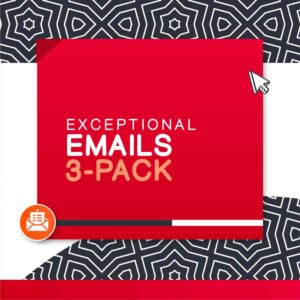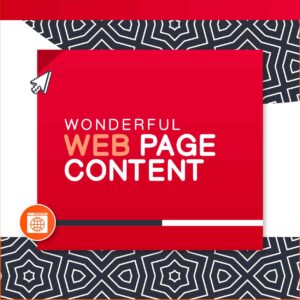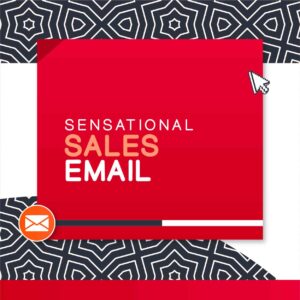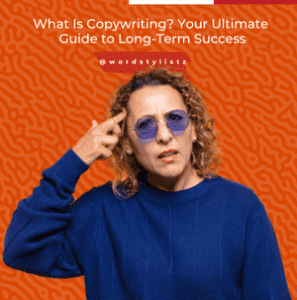
What Is Copywriting? Your Ultimate Guide for Long-term Success
What is copywriting? While the definition may vary slightly depending on who you ask, our straightforward definition is this: Copywriting is the art of having
The Product Lounge is now closed. All final orders will be delivered within 10 business days. Please see Terms and Conditions for more details.
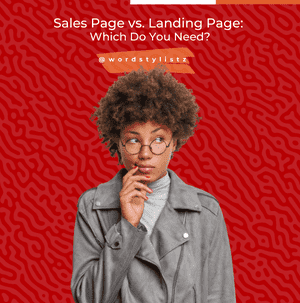
What’s the difference between a sales page vs. landing page? In short, landing pages are used to gather contact information, while sales pages are used to collect money. See, a landing page is vital in attracting potential leads into your business. Brands use these pages to showcase enticing offers, such as an e-book, free training, or a guide, in exchange for the visitor’s contact information.
The components of a successful landing page include a headline, an irresistible offer, benefits of the offer (often in bullet form), and an opt-in button. Optional elements include a brief overview of the expert behind the offer and their background, skills, and experience.
On the other hand, a sales page is designed to entice visitors to not just provide contact information but to make a purchase. The goal of a sales page is to convert leads into buyers. Elements of a persuasive sales page include an intriguing headline, pain story, pain reliever, call to action (CTA), testimonials, and a summary of the expert’s credentials.
Understanding the difference between a sales page vs. landing page is vital for businesses looking to drive conversions and generate leads. Recognizing the purpose and design of each type of page can help you create a more enticing online presence.
A landing page is a stand-alone webpage created to convert visitors into leads. It typically includes a clear headline, a lead magnet offer (such as a free e-book or webinar) and a form for visitors to fill out to receive the offer. The goal of a landing page is to capture the visitor’s information so the brand can follow up with them later.
A sales page, on the other hand, is designed to turn leads into buyers. It typically includes a clear description of the product or service, benefits and features, testimonials and a CTA button. A sales page is usually a part of a larger website, and its main purpose is to sell a product or service.
According to research by HubSpot, landing pages that are specifically designed to generate leads typically have higher conversion rates than generic pages on a website. This is because the page’s only goal is to capture the visitor’s information.
Alternatively, sales pages need to be well-designed and highly persuasive to convince visitors to make a purchase.
In terms of design, landing pages are often kept simple, with minimal distractions and a clear focus on the lead magnet offer. Sales pages, on the other hand, may include more elements, such as images, videos, and testimonials, to help persuade visitors to make a purchase.
Ultimately, the difference between a sales page vs. landing page comes down to the goal of each page. Landing pages are designed to generate leads, while sales pages are designed to sell products or services.
So, which is better – a sales page or a landing page? Landing pages and sales pages play important roles in a business’s online presence. Understanding the difference between the two and designing pages that are tailored to specific goals can help you generate leads and drive conversions more effectively.
To dig deeper into the discussion, we must also explore how landing pages differ from all other website pages. Landing pages are an important component of a brand’s lead generation strategy and differ from all other website pages in several ways, including:
Landing pages are designed with a specific goal in mind – to convert visitors into leads. Unlike other pages on a website, which may provide information about the business or its products and services, landing pages are specifically designed to encourage visitors to take specific actions. This could be by filling out a form, downloading a free resource, or signing up for a trial, for example.
Landing pages typically have a clear, concise message and minimal distractions. Unlike other pages on a website, which may include a variety of links, a visible navigation bar, and other elements, landing pages are designed to be simple and focused. This helps visitors stay focused on the offer and take the desired action more easily.
Landing pages often use strong CTAs and lead magnets to encourage visitors to take action. As mentioned, a lead magnet is a valuable resource, such as an e-book or webinar, that businesses offer in exchange for a visitor’s contact information. This helps brands build a list of qualified leads they can follow up with later.
Landing pages are often tested to determine which design elements and messaging resonate best with visitors. This process of testing and optimizing landing pages is called conversion rate optimization (CRO) and can help businesses improve the effectiveness of their landing pages over time.
Ultimately, landing pages that are designed with a clear goal, minimal distractions, and strong CTAs can generate conversion rates that are several times higher than other pages on a website.
We’ve discussed the difference between a sales page vs. landing page but what about the difference between a landing page and a sales funnel? Landing pages and sales funnels are both vital elements of a successful online marketing strategy, but they are not the same thing.
A landing page is a single page on a website that is designed to convert visitors into leads. It typically includes a headline, lead magnet, benefits, opt-in button and a brief description of the expert behind the offer. The goal of a landing page is to collect contact information from visitors who are interested in learning more about a business’s offer.
A sales funnel, on the other hand, is a series of pages that a visitor travels through to move from awareness to purchase. The funnel typically starts with a landing page, which captures a visitor’s contact information, and then moves through several stages, such as lead nurturing, qualification, and closing.
According to HubSpot, a well-designed sales funnel can increase the effectiveness of a marketing campaign by 50%. A sales funnel can help businesses better understand their target audience, communicate with leads effectively and close more sales.
To build an effective sales funnel, you must first create landing pages that are focused, simple, and optimized for conversions. These landing pages can then be connected to other pages in the funnel, such as lead nurturing pages, qualification pages, and closing pages, to create a seamless experience for the visitor.
To summarize, a landing page is a single page designed to turn visitors into leads, while a sales funnel is a series of pages that a visitor travels through to move from awareness to purchase.
A well-designed sales funnel can increase the effectiveness of a marketing campaign and help businesses better understand their target audience, communicate with leads effectively and close more sales.
When exploring the difference between a sales page vs. landing page, seeing real-life examples makes it easier to understand the flow, design and purpose of each type of page.
Here are 3 great landing page examples and what makes them effective:
Dropbox: Dropbox is a file-sharing platform that uses landing pages to drive conversions. One of their landing pages is a great example of a well-designed landing page. It has a clear headline, a clear value proposition and a simple and effective call to action. The page also has a clear and simple design that makes it easy for visitors to understand the offer and take action.
HubSpot: HubSpot is a marketing, sales and service platform that uses landing pages to drive conversions. One of their landing pages is a great example of a well-designed landing page. The page has a clear headline, a clear value proposition and a simple and effective call to action. The page also has a clean design that makes it easy for visitors to understand the offer and take action.
As a leading copywriting services business, we use landing pages to attract leads and drive conversions. One of our landing pages showcases our popular Cash Kit, a free offer for sales writing templates featuring a 39-page e-book filled with step-by-step writing guidance and 7 failproof sales writing templates.
The page is simple, yet effective, with a clear headline, a clear value proposition, and a strong call to action. What makes this landing page great is its clean design, clear messaging, and the fact that it’s optimized for conversions.
These landing page examples show that a great landing page should have a clear headline, a clear value proposition, and a simple and effective call to action.
A great landing page should also have a clean design that makes it easy for visitors to understand the offer and take action. By focusing on these key elements, businesses can create landing pages that drive conversions and grow their online presence.
Now, what’s the difference between a sales page vs. landing page? A sales page gets you paid while a landing page prepares you to get paid by attracting interested, qualified leads. BUT both play a vital role in your success as an online business.
So, why choose one when you should use both … over and over again. As discussed, a well-designed landing page will help you attract and convert qualified leads, while a well-designed sales page will help you sell your products or services and increase your revenue.
However, creating sales pages and landing pages that are effective and convert can be a complex and time-consuming process. This is why it’s a good idea to hire a professional copywriter to help you determine whether you need a sales page vs. landing page and create these pages for you.
See, a professional copywriter knows how to write persuasive and compelling copy that resonates with your target audience and drives conversions. We have a deep understanding of consumer psychology and the art of persuasion, and we can help you create landing and sales pages that convert browsers into buyers.
Want to maximize the success of your online business? We got you covered at Word Stylistz. With our expertise, you’ll get landing and sales pages that will help you attract and convert more leads, grow your business and achieve your online marketing goals. Get started today and begin reaping the benefits of compelling landing pages.

What is copywriting? While the definition may vary slightly depending on who you ask, our straightforward definition is this: Copywriting is the art of having
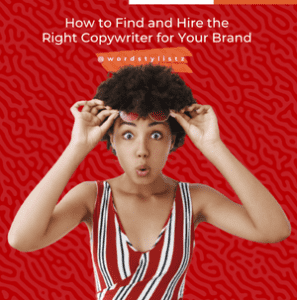
Finding and hiring the right copywriter for your brand is an important decision that can have a significant impact on the success of your online

The Rihanna marketing strategy and her overall Savage-Fenty campaign are two prime examples of how to create an attention-grabbing content and stamp your brand in
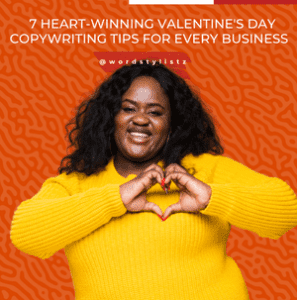
Valentine’s Day is a time to celebrate love and affection, and what better way to show love to our business and clients than by collecting
